Craftworks 1/32
Messerschmitt Bf109K-4/6 | 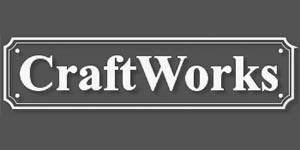 | Introduction I intended to begin this kit review with a technical description of the Messerschmitt Bf109K, the last variant of the famous 109 series to see service in World War II. I looked through the 109 references at my disposal and concluded that Craftworks, the manufacturers of the kit previewed here, provides a very informative description of the plane on their instruction sheet: “The Bf109K-4 entered service in October of 1944, with III/JG27 and III/JG77 being the first units to operate the latest variant of this classic fighter. Recognizable by the tall tail, long tail wheel strut, Erla Haube canopy, asymmetrical cowl and long rectangular wing bulges, the Bf109K was fast and maneuverable. It was equipped with a DB605D engine, which produced 1800 or 2000 hp with Methanol/Water injection (which was good for a ten minute boost). The DB605L with its two-stage supercharger and four bladed propeller was used on Bf109K-14 aircraft. The DB605L showed considerably better performance at altitude; the climb rate at 12000 meters was 5.5 m/sec vs 2.45m/sec for the DB605D. The Bf109K-14 and Bf109K-6 were armed with two MK 108 30mm cannons within each wing, in addition to the single MK 108 30mm cannon firing through the spinner and the two MK 131 fuselage mounted machine guns as found on Bf109K-4 aircraft. Though neither the K-14 or the K-6 was produced in significant numbers before war’s end, two K-14s were assigned to II/JG52 and one K-6 was assigned to the 1st Fliegerdivision (probably III/JG3) in February of 1945.” The Kit 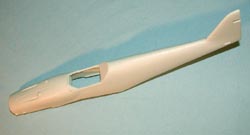 Contained in a VERY stout cardboard box (indeed, all model boxes should be as stout) are approximately 160 pieces. 73 of these pieces are photo-etched and are contained on two comprehensive frets. The parts count is actually higher if the well molded, multi piece pilot figure is included. The rest of the pieces are wire, plastic rod, vacuformed plastic (canopy), white metal and resin with the majority of pieces cast in the latter material. All the resin is cast to a very high standard, with very few pin holes. This is truly a multimedia kit and it also includes an excellent pair of Moskit exhausts, which is quite a coup for Craftworks. Contained in a VERY stout cardboard box (indeed, all model boxes should be as stout) are approximately 160 pieces. 73 of these pieces are photo-etched and are contained on two comprehensive frets. The parts count is actually higher if the well molded, multi piece pilot figure is included. The rest of the pieces are wire, plastic rod, vacuformed plastic (canopy), white metal and resin with the majority of pieces cast in the latter material. All the resin is cast to a very high standard, with very few pin holes. This is truly a multimedia kit and it also includes an excellent pair of Moskit exhausts, which is quite a coup for Craftworks.
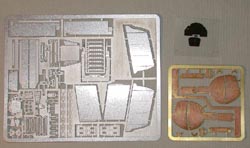 A closer look at the kit contents reveals the following: a one-piece fuselage with a separate lower cowl and rudder. The fuselage is thoughtfully protected with bubble wrap and so are the wingtips. The tail wheel doors are molded closed and separate open doors are supplied on one of the two photo-etched frets. The scribing on the fuselage and wing is very fine and well done. There is fair amount of cleanup to do along the underside of fuselage, which is where I think the casting block was located before its removal. All of the vents on the nose and fuselage are molded open, which is a very impressive bit of casting. Equally impressive is the integrally molded actuator for the trim tab, with clear space between the actuator bar and rudder. This is more accurate than molding the actuator flat against the rudder. A closer look at the kit contents reveals the following: a one-piece fuselage with a separate lower cowl and rudder. The fuselage is thoughtfully protected with bubble wrap and so are the wingtips. The tail wheel doors are molded closed and separate open doors are supplied on one of the two photo-etched frets. The scribing on the fuselage and wing is very fine and well done. There is fair amount of cleanup to do along the underside of fuselage, which is where I think the casting block was located before its removal. All of the vents on the nose and fuselage are molded open, which is a very impressive bit of casting. Equally impressive is the integrally molded actuator for the trim tab, with clear space between the actuator bar and rudder. This is more accurate than molding the actuator flat against the rudder.
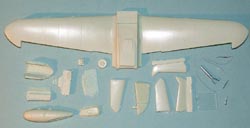 The one-piece wing has separate control surfaces as well as upper wing bulges, but the leading edge slats and navigation lights are integrally cast. I can well imagine that casting these slats to scale thickness would result in parts that would not survive the packaging process! The ailerons and wing radiators are resin and the flaps are photo-etched. The horizontal stabilsers also feature separated control surfaces. The cockpit floor is cast into the upper wing surface. You will also have to remove the remnants of the casting block from the leading edge of the wing. The photo-etched frets include the wheel well liner and canvas covers for the wheel well inspection ports. There is an accurate drop tank and rack, two spinners and four prop blades. Separate wing cannon for the K-6 and K-14 variants are included in the bag containing the 4 bladed spinner (the K-6 used the standard 3 blade prop) for the K-14. The one-piece wing has separate control surfaces as well as upper wing bulges, but the leading edge slats and navigation lights are integrally cast. I can well imagine that casting these slats to scale thickness would result in parts that would not survive the packaging process! The ailerons and wing radiators are resin and the flaps are photo-etched. The horizontal stabilsers also feature separated control surfaces. The cockpit floor is cast into the upper wing surface. You will also have to remove the remnants of the casting block from the leading edge of the wing. The photo-etched frets include the wheel well liner and canvas covers for the wheel well inspection ports. There is an accurate drop tank and rack, two spinners and four prop blades. Separate wing cannon for the K-6 and K-14 variants are included in the bag containing the 4 bladed spinner (the K-6 used the standard 3 blade prop) for the K-14.
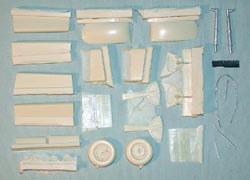 All of the parts are contained in separate plastic bags pertaining to a particular part of the plane-cockpit (2 bags), nose (2 bags) wing, etc. The landing gear and tail wheel strut are white metal, which is a sensible given the weight of the finished model. I think that it will be quite heavy! The antenna mast and under wing “Morane” antenna mast are also white metal. The landing gear doors include the rarely used outer gear doors and are a multi piece mix of resin and photo-etch. The outer parts are photo-etch and the inner parts are resin. All of the parts are contained in separate plastic bags pertaining to a particular part of the plane-cockpit (2 bags), nose (2 bags) wing, etc. The landing gear and tail wheel strut are white metal, which is a sensible given the weight of the finished model. I think that it will be quite heavy! The antenna mast and under wing “Morane” antenna mast are also white metal. The landing gear doors include the rarely used outer gear doors and are a multi piece mix of resin and photo-etch. The outer parts are photo-etch and the inner parts are resin.
The cockpit has separate sidewalls, cannon breech cover, oxygen hose, etc. and is exceptionally well done. Craftworks made some very interesting choices for the materials used in the cockpit. For example, the trim wheel, flap wheel, and control stick are resin. I might have expected the first two items to be photo-etched (like the rudder pedals) and the control column to be white metal. The canopy is a multimedia piece is its own right with a vacuformed interior and resin exterior (it appears that the resin windscreen is missing from the sample kit) and separate Galland Panzer canopy armor. All of the parts necessary to make the canopy anchor cable from wire are included in addition to clear plastic sheet for the armored glass in the Galland Panzer armor. The modeler will be hard pressed to find a more comprehensive and challenging modeling experience in this scale. Or any other scale, for that matter. 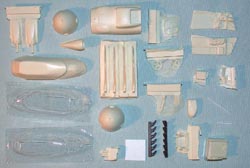 If that was not enough the kit also includes a decal sheet for no less than 23 different aircraft (designed by the publisher of this website, Chris Banyai-Riepl), 2 sets of wing camouflage pattern masks, a layout for the decal sheet and a guide to stencil placement, a key for the photo-etched frets, masks for spinner spirals, a sheet of G-10 detail photos (there are no surviving Ks), and a sheet of color profiles depicting seven of the available decal options. All things considered, a very impressive package. The decal sheet lacks wing walk decals, however. If that was not enough the kit also includes a decal sheet for no less than 23 different aircraft (designed by the publisher of this website, Chris Banyai-Riepl), 2 sets of wing camouflage pattern masks, a layout for the decal sheet and a guide to stencil placement, a key for the photo-etched frets, masks for spinner spirals, a sheet of G-10 detail photos (there are no surviving Ks), and a sheet of color profiles depicting seven of the available decal options. All things considered, a very impressive package. The decal sheet lacks wing walk decals, however.
Instructions I cannot give the instructions the same high ratings as the rest of the kit for the following reasons: 1) The artwork is only fair. This is an aesthetic preference: the artwork conveys what is required, but it could better executed. 2) The assembly sequences are numbered but the parts are not. 3) Some of the color recommendations are suspect. For example, only early Ks had the landing gear painted RLM 66, not ALL of them. On later planes the landing gear were 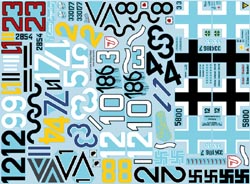 RLM 66, RLM 02 Grau or unpainted. And the wheels were usually, but not always, black rather than 66. 4) The instruction cite two primary sources for pictures and profiles of the planes on the decal sheet, the Hall-Park Warpaint Special No.2 and Messerschmitt Bf109K Camouflage and Markings by JaPo Publications. I own the latter book but not the former. In five separate instances the same page is cited in both pages for pictures or a profile of a specific plane, and in none of these cases were the planes found on the pages cited for the JaPo book! Three different 109s are supposed to be on page 55 (“White 12”, “White 16”, and “Yellow 8”), which is highly unlikely given that one finds a full-page color profile on page 55! Finally, “Black 1”, 10./JG51, cannot be built from this kit without major modification. This plane was assembled from salvaged parts and the starboard cowl came from a G-14. This cowl is a completely different shape than that of a K. RLM 66, RLM 02 Grau or unpainted. And the wheels were usually, but not always, black rather than 66. 4) The instruction cite two primary sources for pictures and profiles of the planes on the decal sheet, the Hall-Park Warpaint Special No.2 and Messerschmitt Bf109K Camouflage and Markings by JaPo Publications. I own the latter book but not the former. In five separate instances the same page is cited in both pages for pictures or a profile of a specific plane, and in none of these cases were the planes found on the pages cited for the JaPo book! Three different 109s are supposed to be on page 55 (“White 12”, “White 16”, and “Yellow 8”), which is highly unlikely given that one finds a full-page color profile on page 55! Finally, “Black 1”, 10./JG51, cannot be built from this kit without major modification. This plane was assembled from salvaged parts and the starboard cowl came from a G-14. This cowl is a completely different shape than that of a K. Accuracy I checked the wing against the scale plans in John Beaman’s Last of the Eagles, and it matched the plans exactly, and I do mean exactly. The fuselage is longer than the plans and the rudder is consequently further back that it should be, and the fuselage is slightly slender in profile between the cockpit and fin. I did not measure any of this but it is both visible and evident. I will leave measurements to the Experten as I do not consider myself to be one of them! There is also a slight yet perceptible taper to the upper edge of the oil tank-indeed on all 109Gs and Ks-that is missed in the kit. This is very subtle, and almost unnoticeable. Most important Craftworks have nicely captured the subtle nuances and curves of the conformal bulges of the cowl, although the port cowl is perhaps narrower than it might be. Finally there is one anomaly that I should mention. 109 fuselages were assembled in halves, and these halves were in turn assembled from individual sections. Each section was numbered and there was a visible seam between each section. For reasons that are unknown to me, 3 of the fuselage sections are wider than the rest (the third, fifth, and seventh), when the fuselage is seen from above, giving the fuselage a curious undulating quality. Why this is the case is a complete mystery to me. One for the Experten? Conclusions In case you could not tell, I am very impressed with this kit. Impressed and a little daunted, although the more I look at the instructions the more excited I become at the prospect of building it. This is a very well designed and engineered kit. I think that a very good replica of this the penultimate variant of Professor Messerschmitt’s famous fighter. Watch this space for more developments! References -
The Last of the Eagles, by John Beaman, Jr., 1976. -
Messerschmitt 109 Camouflage and Marking, JaPo Publications, 2000. -
Messerschmitt Bf109K, JaPo Publications, 1998(?). | 








|

 Contained in a VERY stout cardboard box (indeed, all model boxes should be as stout) are approximately 160 pieces. 73 of these pieces are photo-etched and are contained on two comprehensive frets. The parts count is actually higher if the well molded, multi piece pilot figure is included. The rest of the pieces are wire, plastic rod, vacuformed plastic (canopy), white metal and resin with the majority of pieces cast in the latter material. All the resin is cast to a very high standard, with very few pin holes. This is truly a multimedia kit and it also includes an excellent pair of Moskit exhausts, which is quite a coup for Craftworks.
Contained in a VERY stout cardboard box (indeed, all model boxes should be as stout) are approximately 160 pieces. 73 of these pieces are photo-etched and are contained on two comprehensive frets. The parts count is actually higher if the well molded, multi piece pilot figure is included. The rest of the pieces are wire, plastic rod, vacuformed plastic (canopy), white metal and resin with the majority of pieces cast in the latter material. All the resin is cast to a very high standard, with very few pin holes. This is truly a multimedia kit and it also includes an excellent pair of Moskit exhausts, which is quite a coup for Craftworks.  A closer look at the kit contents reveals the following: a one-piece fuselage with a separate lower cowl and rudder. The fuselage is thoughtfully protected with bubble wrap and so are the wingtips. The tail wheel doors are molded closed and separate open doors are supplied on one of the two photo-etched frets. The scribing on the fuselage and wing is very fine and well done. There is fair amount of cleanup to do along the underside of fuselage, which is where I think the casting block was located before its removal. All of the vents on the nose and fuselage are molded open, which is a very impressive bit of casting. Equally impressive is the integrally molded actuator for the trim tab, with clear space between the actuator bar and rudder. This is more accurate than molding the actuator flat against the rudder.
A closer look at the kit contents reveals the following: a one-piece fuselage with a separate lower cowl and rudder. The fuselage is thoughtfully protected with bubble wrap and so are the wingtips. The tail wheel doors are molded closed and separate open doors are supplied on one of the two photo-etched frets. The scribing on the fuselage and wing is very fine and well done. There is fair amount of cleanup to do along the underside of fuselage, which is where I think the casting block was located before its removal. All of the vents on the nose and fuselage are molded open, which is a very impressive bit of casting. Equally impressive is the integrally molded actuator for the trim tab, with clear space between the actuator bar and rudder. This is more accurate than molding the actuator flat against the rudder.  The one-piece wing has separate control surfaces as well as upper wing bulges, but the leading edge slats and navigation lights are integrally cast. I can well imagine that casting these slats to scale thickness would result in parts that would not survive the packaging process! The ailerons and wing radiators are resin and the flaps are photo-etched. The horizontal stabilsers also feature separated control surfaces. The cockpit floor is cast into the upper wing surface. You will also have to remove the remnants of the casting block from the leading edge of the wing. The photo-etched frets include the wheel well liner and canvas covers for the wheel well inspection ports. There is an accurate drop tank and rack, two spinners and four prop blades. Separate wing cannon for the K-6 and K-14 variants are included in the bag containing the 4 bladed spinner (the K-6 used the standard 3 blade prop) for the K-14.
The one-piece wing has separate control surfaces as well as upper wing bulges, but the leading edge slats and navigation lights are integrally cast. I can well imagine that casting these slats to scale thickness would result in parts that would not survive the packaging process! The ailerons and wing radiators are resin and the flaps are photo-etched. The horizontal stabilsers also feature separated control surfaces. The cockpit floor is cast into the upper wing surface. You will also have to remove the remnants of the casting block from the leading edge of the wing. The photo-etched frets include the wheel well liner and canvas covers for the wheel well inspection ports. There is an accurate drop tank and rack, two spinners and four prop blades. Separate wing cannon for the K-6 and K-14 variants are included in the bag containing the 4 bladed spinner (the K-6 used the standard 3 blade prop) for the K-14.  All of the parts are contained in separate plastic bags pertaining to a particular part of the plane-cockpit (2 bags), nose (2 bags) wing, etc. The landing gear and tail wheel strut are white metal, which is a sensible given the weight of the finished model. I think that it will be quite heavy! The antenna mast and under wing “Morane” antenna mast are also white metal. The landing gear doors include the rarely used outer gear doors and are a multi piece mix of resin and photo-etch. The outer parts are photo-etch and the inner parts are resin.
All of the parts are contained in separate plastic bags pertaining to a particular part of the plane-cockpit (2 bags), nose (2 bags) wing, etc. The landing gear and tail wheel strut are white metal, which is a sensible given the weight of the finished model. I think that it will be quite heavy! The antenna mast and under wing “Morane” antenna mast are also white metal. The landing gear doors include the rarely used outer gear doors and are a multi piece mix of resin and photo-etch. The outer parts are photo-etch and the inner parts are resin.  If that was not enough the kit also includes a decal sheet for no less than 23 different aircraft (designed by the publisher of this website, Chris Banyai-Riepl), 2 sets of wing camouflage pattern masks, a layout for the decal sheet and a guide to stencil placement, a key for the photo-etched frets, masks for spinner spirals, a sheet of G-10 detail photos (there are no surviving Ks), and a sheet of color profiles depicting seven of the available decal options. All things considered, a very impressive package. The decal sheet lacks wing walk decals, however.
If that was not enough the kit also includes a decal sheet for no less than 23 different aircraft (designed by the publisher of this website, Chris Banyai-Riepl), 2 sets of wing camouflage pattern masks, a layout for the decal sheet and a guide to stencil placement, a key for the photo-etched frets, masks for spinner spirals, a sheet of G-10 detail photos (there are no surviving Ks), and a sheet of color profiles depicting seven of the available decal options. All things considered, a very impressive package. The decal sheet lacks wing walk decals, however. RLM 66, RLM 02 Grau or unpainted. And the wheels were usually, but not always, black rather than 66. 4) The instruction cite two primary sources for pictures and profiles of the planes on the decal sheet, the Hall-Park Warpaint Special No.2 and Messerschmitt Bf109K Camouflage and Markings by JaPo Publications. I own the latter book but not the former. In five separate instances the same page is cited in both pages for pictures or a profile of a specific plane, and in none of these cases were the planes found on the pages cited for the JaPo book! Three different 109s are supposed to be on page 55 (“White 12”, “White 16”, and “Yellow 8”), which is highly unlikely given that one finds a full-page color profile on page 55! Finally, “Black 1”, 10./JG51, cannot be built from this kit without major modification. This plane was assembled from salvaged parts and the starboard cowl came from a G-14. This cowl is a completely different shape than that of a K.
RLM 66, RLM 02 Grau or unpainted. And the wheels were usually, but not always, black rather than 66. 4) The instruction cite two primary sources for pictures and profiles of the planes on the decal sheet, the Hall-Park Warpaint Special No.2 and Messerschmitt Bf109K Camouflage and Markings by JaPo Publications. I own the latter book but not the former. In five separate instances the same page is cited in both pages for pictures or a profile of a specific plane, and in none of these cases were the planes found on the pages cited for the JaPo book! Three different 109s are supposed to be on page 55 (“White 12”, “White 16”, and “Yellow 8”), which is highly unlikely given that one finds a full-page color profile on page 55! Finally, “Black 1”, 10./JG51, cannot be built from this kit without major modification. This plane was assembled from salvaged parts and the starboard cowl came from a G-14. This cowl is a completely different shape than that of a K.







